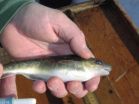(Press-News.org) NEW YORK, Feb. 17, 2011 – A research group led by a New York University School of Medicine scientist discovered a genetic variant that allows a fish in the Hudson River to live in waters heavily polluted by PCBs. In a study published in the February 18, 2011, online issue of Science, they report that a population of Hudson River fish apparently evolved rapidly in response to the toxic chemicals, which were first introduced in 1929, and were banned fifty years later. PCBs, or polychlorinated biphenyls, were used in hundreds of industrial and commercial applications, especially as electrical insulators.
"We've found evolutionary change going on very quickly due to toxic exposure, and just one gene is responsible for it," says Isaac Wirgin, a population geneticist, associate professor of environmental medicine at NYU School of Medicine, and the study's lead investigator. "There are not many examples of this in the scientific literature."
General Electric released approximately 1.3 million pounds of PCBs into the Hudson River from 1947 to 1976. The Atlantic tomcod, Microgadus tomcod, is a common bottom-feeding fish in the Hudson that is not usually eaten by humans. The fish, which typically reaches a length of 10 inches, had long been known to survive exposure to PCBs, and levels of the chemical in its liver are among the highest reported in nature. However, scientists did not understand the biological mechanism that allowed the tomcod to survive chemical exposures that kill most other fishes.
Dr. Wirgin and scientists at NOAA Fisheries Service in New Jersey and the Woods Hole Oceanographic Institution in Massachusetts spent four years capturing tomcod from contaminated and relatively clean areas of the Hudson River during the winter months, when tomcod spawn in the river. The fish were screened for genetic variants in a gene encoding a protein known to regulate the toxic effects of PCBs, which is called the aryl hydrocarbon receptor2, or AHR2. This gene also is involved in mediating the effects of other halogenated hydrocarbon compounds, a group that includes PCBs.
Slight alterations—the deletion of only six base pairs in DNA of the AHR2 gene—appear to protect tomcod from PCBs, according to the study. Normally, when unaltered AHR2 binds to PCBs, it triggers a cascade of reactions that transmit the toxic effects of the compound. However, the study found that PCBs bind poorly to the variant AHRs, which apparently blunts the chemicals' effects.
Tomcod from cleaner waters occasionally carried mutant AHR2, suggesting that these variants existed in minor proportions prior to PCB pollution, says Dr. Wirgin. After the chemical was released, tomcod carrying the mutation had an advantage over others in the population because PCBs otherwise lead to lethal heart defects in young fish. The study's findings suggest that this advantage drove genetic changes in these fish over some fifty years. "We think of evolution as something that happens over thousands of generations," says Dr. Wirgin. "But here it happened remarkably quickly."
INFORMATION:
The study co-authors are: Nirmal K. Roy and Matthew Loftus, the NYU School of Medicine; R. Christopher Chambers, the NOAA Fisheries Service, Highland, New Jersey; and Diana G. Franks and Mark E. Hahn, Woods Hole Oceanographic Institution.
About NYU School of Medicine:
NYU School of Medicine is one of the nation's preeminent academic institutions dedicated to achieving world class medical educational excellence. For 170 years, NYU School of Medicine has trained thousands of physicians and scientists who have helped to shape the course of medical history and enrich the lives of countless people. An integral part of NYU Langone Medical Center, the School of Medicine at its core is committed to improving the human condition through medical education, scientific research and direct patient care. The School also maintains academic affiliations with area hospitals, including Bellevue Hospital, one of the nation's finest municipal hospitals where its students, residents and faculty provide the clinical and emergency care to New York City's diverse population, which enhances the scope and quality of their medical education and training. Additional information about the NYU School of Medicine is available at http://school.med.nyu.edu/.
A genetic mutation allows Hudson River fish to adapt to PCBs
2011-02-18
ELSE PRESS RELEASES FROM THIS DATE:
Turning forests into fuel: New report outlines promise and limits of biomass energy in the Northeast
2011-02-18
(Millbrook, N.Y. – Feb 17, 2011) Forest biomass could replace as much as one quarter of the liquid fossil fuel now being used for industrial and commercial heating in the Northeastern United States. That's according to a new report released today by the Cary Institute of Ecosystem Studies.
But the report also has sharp caveats: The potential for forest biomass varies widely within the region, and forest resources must be carefully managed to protect the other important services and goods they provide. Under the right circumstances, however, the report found that forest ...
Unraveling how prion proteins move alon axons in the brain
2011-02-18
Researchers at the University of California, San Diego School of Medicine have identified the motors that move non-infectious prion proteins (PrPC) – found within many mammalian cells – up and down long, neuronal transport pathways. Identifying normal movement mechanisms of PrPC may help researchers understand the spread of infectious prions within and between neurons to reach the brain, and aid in development of therapies to halt the transport.
Their study is published in the February 18 edition of the journal Cell.
The small prion protein is found in the cell membrane ...
Pollution triggers genetic resistance mechanism in a coastal fish
2011-02-18
For 30 years, two General Electric facilities released about 1.3 million pounds of polychlorinated biphenyls (PCBs) into New York's Hudson River, devastating and contaminating fish populations. Some 50 years later, one type of fish—the Atlantic tomcod—has not only survived but appears to be thriving in the hostile Hudson environment.
Researchers from Woods Hole Oceanographic Institution (WHOI) have joined colleagues from New York University (NYU) and NOAA to investigate this phenomenon and report that the tomcod living in the Hudson River have undergone a rapid evolutionary ...
Study links social security improvements to longer life span
2011-02-18
New findings from researchers at New York Medical College suggest that when Social Security benefits are improved, people over the age of 65 benefit most, and may even live longer.
According to a new study published in the Journal of Public Health Policy, Americans over the age of 65 experienced steep declines in the rate of mortality in the periods that followed the founding of and subsequent improvements to Social Security. The authors urge that as Congress and the President discuss changes to Social Security they consider the benefit of reduced mortality and improved ...
World's first chemical guided missile could be the answer to wiping out cancer
2011-02-18
Deakin University medical scientists have created the world's first cancer stem cell-targeting chemical missile, placing them a step closer to creating a medical 'smart bomb' that would seek out and eradicate the root of cancer cells.
The Deakin researchers have worked with scientists in India and Australia to create the world's first RNA aptamer, a chemical antibody that acts like a guided missile to seek out and bind only to cancer stem cells. The aptamer has the potential to deliver drugs directly to the stem cells (the root of cancer cells) and also to be used to ...
Swedish discovery could lead to new stroke therapy
2011-02-18
The only acute treatment for a stroke currently available is thrombolysis. This uses drugs that dissolve the blood clot responsible for the stroke, but it only reaches around 10 per cent of stroke patients in time to prevent lasting damage. For other patients, there are no other effective drugs that reduce the loss of brain function following a stroke.
Researchers at the Laboratory for Experimental Brain Research in Lund, together with American researchers, have discovered a substance that reinforces the brain's self-healing functions after a stroke. It has long been ...
Choose less contaminating products thanks to eco-labeling
2011-02-18
Ensuring the sustainability of the products we use is a fundamental challenge for society, and is becoming ever more important for consumers and companies. A researcher from the University of Santiago de Compostela (USC) has come up with an eco-labelling system that provides environmental information, showing the carbon footprints generated by the goods and services in question during their "life cycle".
"This study provides an alternative means of efficiently communicating environmental information to companies, consumers and interested parties – the eco-label. This ...
Sleeping Trojan horse to aid imaging of diseased cells
2011-02-18
A unique strategy developed by researchers at Cardiff University is opening up new possibilities for improving medical imaging.
Medical imaging often requires getting unnatural materials such as metal ions into cells, a process which is a major challenge across a range of biomedical disciplines. One technique currently used is called the 'Trojan Horse' in which the drug or imaging agent is attached to something naturally taken up by cells.
The Cardiff team, made of researchers from the Schools of Chemistry and Biosciences, has taken the technique one step further with ...
Cell-phone use not related to increased brain cancer risk
2011-02-18
Radio frequency exposure from cell phone use does not appear to increase the risk of developing brain cancers by any significant amount, a study by University of Manchester scientists suggests.
The researchers used publically available data from the UK Office of National Statistics to look at trends in rates of newly diagnosed brain cancers in England between 1998 and 2007.
The study, published in the journal Bioelectromagnetics, reported no statistically significant change in the incidence of brain cancers in men or women during the nine-year time period under observation.
"Cell ...
Emotional response may predict how the body responds to stress
2011-02-18
New York, NY, 17 February 2011 – Your emotional response to challenging situations could predict how your body responds to stress, according to research published this month in the journal Brain, Behavior, and Immunity.
"People who reported high levels of anger and anxiety after performing a laboratory-based stress task showed greater increases in a marker of inflammation, than those who remained relatively calm," said Dr Judith Carroll, who conducted the study at the University of Pittsburgh. "This could help explain why some people with high levels of stress experience ...


